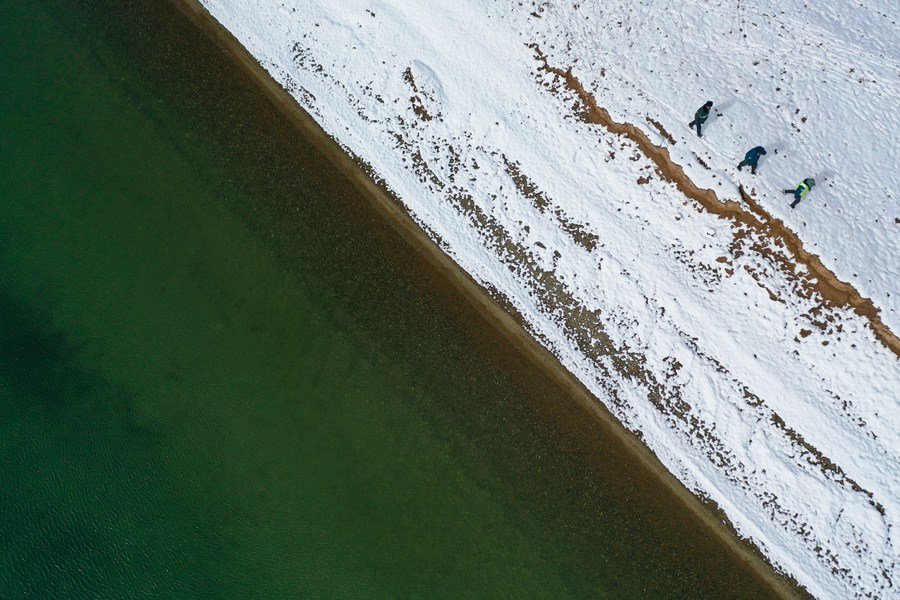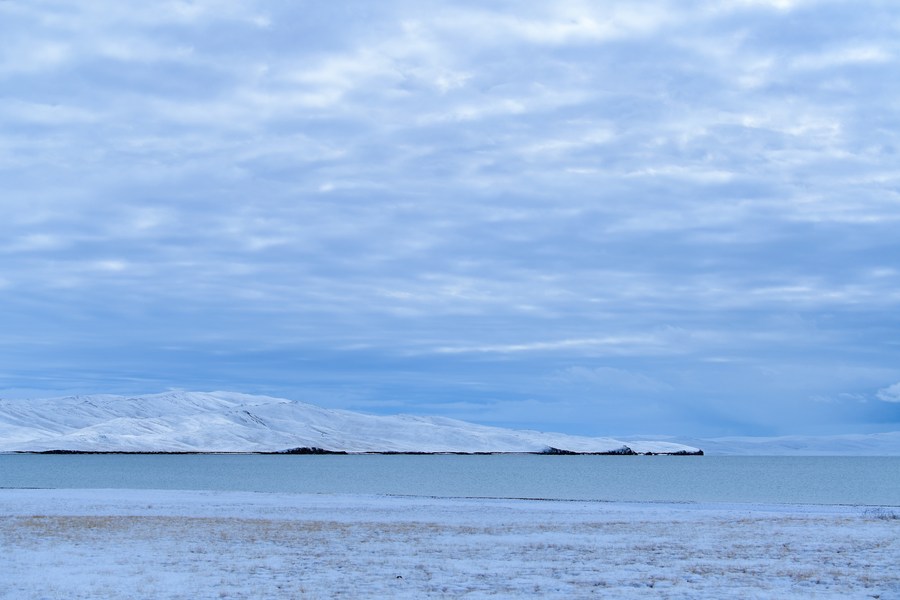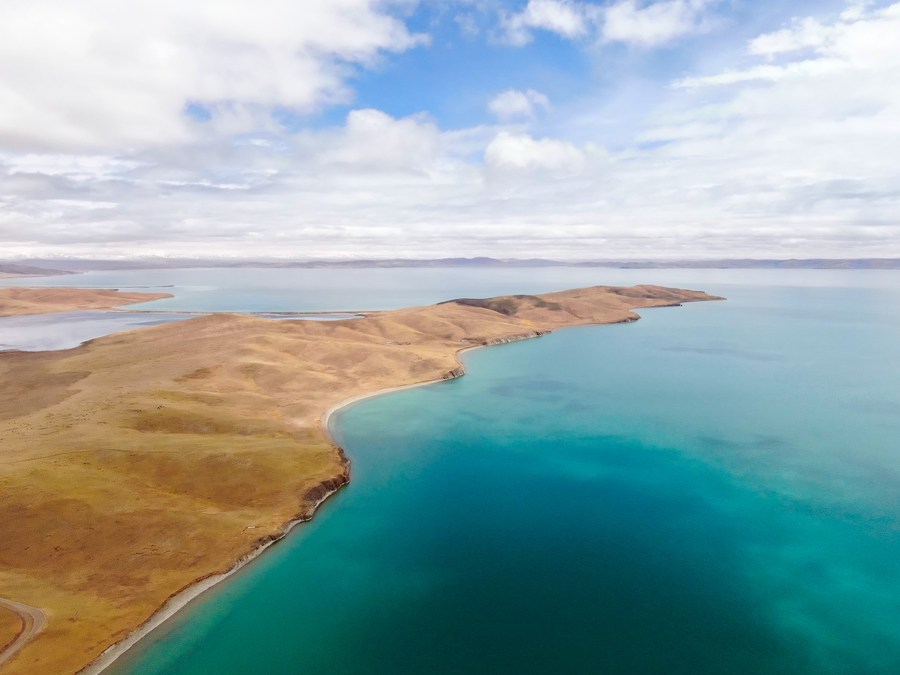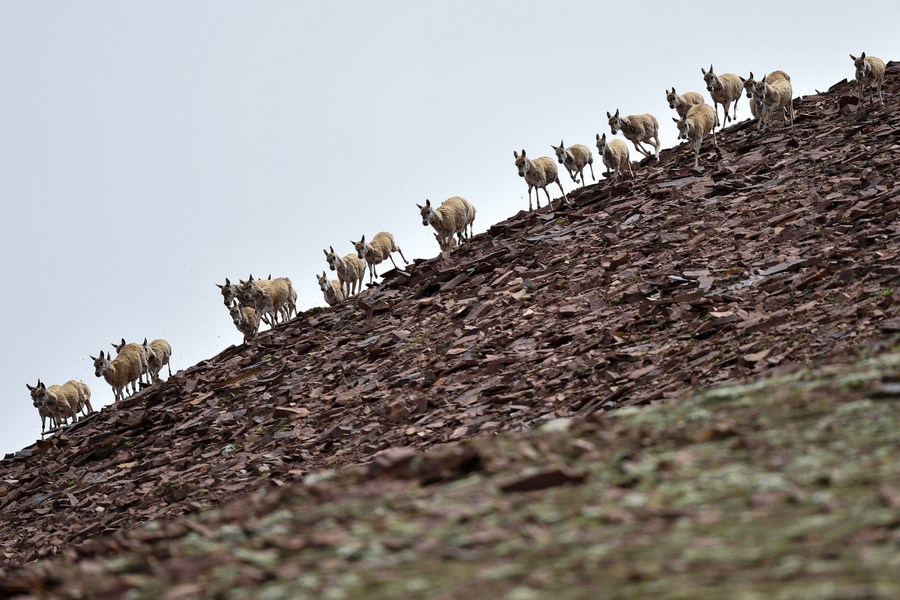
For the past decade, Tibetan ranger Gechok has typically started his day with the same routine, waking up in the early morning and riding on horseback to the source region of the Yellow River.
He spends seven hours a day on patrol, covering dozens of kilometers, taking notes on the occurrence and activities of wild animals, vegetation growth and changes to the snow line. The details are jotted in a notebook and then collated, before being sent in reports to environmental protection professionals.
"Previously, the animals and plants were just scenery to me. But when I became a ranger, I learned the recording methods from professionals, and realized that these are scientific research materials, which can be used to better protect the ecological environment," he said.

In this aerial photo, rangers patrol in the Sanjiangyuan National Park in Madoi County of Golog Tibetan Autonomous Prefecture, northwest China's Qinghai Province, Oct. 20, 2021. (Xinhua/Zhang Long)
Gechok is among over 20,000 herders who have secured new jobs as rangers in Sanjiangyuan National Park in northwest China's Qinghai Province, which sits at an average altitude of more than 4,700 meters.
The Sanjiangyuan area is known as Asia's "water tower" as it contains the headwaters of the Yangtze, Yellow and Lancang rivers.
Previously, due to climate change and various human activities, the Sanjiangyuan suffered serious ecological degradation, with a large number of lakes disappearing and wildlife declining sharply.
In recent years, however, the situation has been largely improved, with concerted and unremitting efforts made by governments at various levels, institutes and grassroots workers.
CONTINUOUS, CONCERTED EFFORTS
Madoi County in Qinghai's Golog Tibetan Autonomous Prefecture, where the Yellow River source region is located, has witnessed changes in its ecological environment over the years.

From the 1960s to 1980s, Madoi's main industry was animal husbandry. At that time, each household in the county possessed hundreds of cattle and sheep, and the development of animal husbandry boosted the local economy.
Therefore, in the early 1980s, Madoi became one of China's richest counties in terms of animal husbandry.
However, from the late 1980s to the beginning of this century, due to the various factors, including the global climate change, the wetlands and lakes in Madoi decreased, grassland vegetation degraded, the water conservation capacity dropped sharply, biodiversity was impacted, and local economic and social development was hampered.
The headwaters of the Yellow River in Madoi were partially dried up between 2003 and 2004, exposing river beds covered in yellow sand.
To restore the ecological environment, the county government has taken a series of measures, including initiating ecological migration programs, imposing a grazing ban in certain areas, and encouraging local herders to participate in ecological protection. The measures have proven effective, with the trend of deterioration in the local ecology reversed.
Madoi is a fine example of China's efforts at improving the ecological environment and biodiversity in the Sanjiangyuan area.
Sun Lijun, deputy director of the Sanjiangyuan National Park administration, said that, starting in 2005, China launched ecological projects which lasted for some 16 years to protect and restore the environment in Sanjiangyuan, with an accumulated investment of more than 22 billion yuan (about 3.19 billion U.S. dollars).
In 2016, China started piloting the Sanjiangyuan National Park. Each household living inside the 190,700-square-km park was offered a job opportunity as a ranger with an annual income of over 21,000 yuan.

A snow leopard is pictured in Zadoi County of Yushu Tibetan Autonomous Prefecture, northwest China's Qinghai Province, Aug. 6, 2022. (Photo by Yao Muyang/Xinhua)
In addition to these efforts, many counties and townships in Sanjiangyuan began to explore their own environmentally-sustainable development modes based on their respective characteristics.
The Namse Township of Qinghai's Yushu Tibetan Autonomous Prefecture, through which the Lancang River flows, is known as the "hometown of snow leopards" due to the frequent sightings of the big cat species.
Starting in 2019, the township piloted a franchise business model for tourism, training some herders to serve as ecological guides to host tourists. Currently, Namse's Nyanthok Village has more than 10 such guides, with each household earning more than 10,000 yuan annually.
Last October, the Sanjiangyuan National Park was officially designated.
POSITIVE SIGNS
Years of unrelenting conservation efforts have yielded positive results.

Aerial photo taken on May 25, 2021 shows a view of Ngoring Lake at the source of the Yellow River section of the Sanjiangyuan National Park in northwest China's Qinghai Province. (Xinhua/Li Zhanyi)
"The Yellow River's headwaters have kept flowing for nearly 16 years," said Gan Xuebin, full-time deputy director of the management bureau of the Yellow River's headwaters region of the park.
Gan added that the number of lakes in Madoi, dubbed "the county of a thousand lakes," increased from the 4,077 recorded in the county annals to 5,849 in 2018, while 104 square kilometers of wetland was newly added by 2018.
According to a press briefing held Wednesday in Qinghai, over the past decade, water conservation in the Sanjiangyuan area has risen by over 6 percent on average each year, while grassland coverage has increased over 11 percent and grass output increased 30 percent.
Additionally, amid efforts to improve wildlife habitats and conserve ecosystems, the populations of wild animals and plants have continued to increase in the Sanjiangyuan area, the press briefing added.
Karma Yingphel, from a protection station under the Sanjiangyuan National Park administration, has been patrolling and protecting rare and endangered species, including Tibetan antelopes, and their habitats in Hoh Xil since 2007, together with his colleagues.

Tibetan antelopes are pictured near Zonag Lake in Hoh Xil, northwest China's Qinghai Province, July 7, 2020. (Xinhua/Zhang Long)
Their hard work has paid off. The population of Tibetan antelopes in Hoh Xil, a species under first-class national protection in China, has increased from less than 20,000 in the 1990s to over 70,000 by 2021.
Moreover, the Shanshui Conservation Center, an organization aiming at nature conservation, has installed nearly 800 infrared cameras in the Sanjiangyuan area over the past decade, taking about 100,000 pictures of the snow leopards, a species under China's highest national-level protection, according to Zhao Xiang from the center.
"So far, we have identified at least 400 individual snow leopards in the area," Zhao said, adding that the distribution density of snow leopards in Sanjiangyuan is higher than the global average, which indicates that this area is the most important snow leopard distribution and habitat in China and the wider world.
"When I was a child, I wanted to become a herdsman when I grew up, like the elder generations. Now, I patrol in wetlands and grasslands, record real-time images and observe the traces of wild animals," said Gechok.
"Being a ranger taught me to understand nature scientifically and to know that the ecological environment is important not only for people, but also for plants and animals," he added.